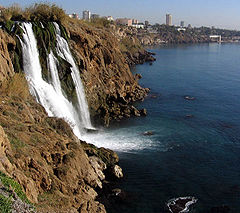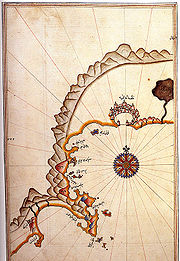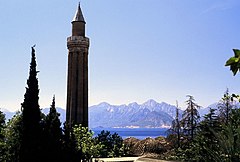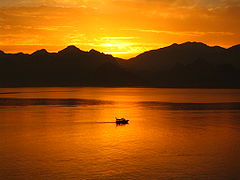Antalya: Difference between revisions
m Undid revision 131114847 by 131.111.141.139 (talk)Rv vandalism |
No edit summary |
||
| Line 12: | Line 12: | ||
|region = Mediterranean |
|region = Mediterranean |
||
|province = Antalya |
|province = Antalya |
||
|population = 677,242 |
|population = 45,677,242 |
||
|population_as_of = 2005 |
|population_as_of = 2005 |
||
|population_ref = [http://www.antalya.bel.tr/en/bel_kurumsal/yetki_alani_haritasi.cfm] |
|population_ref = [http://www.antalya.bel.tr/en/bel_kurumsal/yetki_alani_haritasi.cfm] |
||
Revision as of 19:47, 16 May 2007
Antalya (formerly known as Adalia; from Pamphylian Greek: Αττάλεια Attália) is a large town and tourist destination, situated on the Mediterranean coast of southwestern Turkey. It is the capital city of Antalya Province. The population of the city is 603,190 (2000 census) but reaches up to two million in summers at the height of tourism season.
Situated on a steep cliff over the Mediterranean, Antalya is a picturesque city surrounded by mountains. Developments in tourism, starting in the 1970s, have transformed the city into an international resort. With its airport and central location, Antalya is "the capital of Turkish tourism", a gateway for the Turkish riviera and many historical sites. Furthermore, with its palm-lined boulevards, its prize-winning marina, the unspoilt historical neighbourhood of Kaleiçi, and the modern developments along the coast, the city of Antalya is a major attraction in its own right. Antalya and its surroundings are a very important part of Turkish tourism.
Antalya has plenty of accommodation, a very hot climate and many places to visit both in and around the city, including traces of Pamphylian, Hellenistic, Roman, Byzantine, Seljuk and Ottoman architecture and cultures.
Atatürk claimed without doubt Antalya is the most beautiful place in the world.
Etymology
In the 1st century BC, the Pergamum king Attalos II ordered his men to find "heaven on earth". After a long search all over the world, they discovered this land and said "This must be 'Heaven' " and King Attalos founded the city giving it the name "Attaleia" (Greek: Αττάλεια) which later became Adalia and then Antalya.[1]
Source : http://www.antalya1.com
History

See Antalya Province for a description of the rich history of this area in antiquity
In 150 BC Attalos II, king of Pergamom, founded the city of Attalia (present day Antalya) to base his powerful naval fleet, and the city grew and prospered in the Ancient Roman and Byzantine periods, later becoming a naval base for the Christian Crusades against the Muslims in the Levant and in Cyprus.
The city, along with the whole region, was conquered by the Seljuk Turks in the early 13th century. The Arabic traveler Ibn Battuta who came to the city in between 1335-1340 noted:
From Alaya I went to Antaliya [Adalia], a most beautiful city. It covers an immense area, and though of vast bulk is one of the most attractive towns to be seen anywhere, besides being exceedingly populous and well laid out. Each section of the inhabitants lives in a separate quarter. The Christian merchants live in a quarter of the town known as the Mina [the Port], and are surrounded by a wall, the gates of which are shut upon them from without at night and during the Friday service. The Greeks, who were its former inhabitants, live by themselves in another quarter, the Jews in another, and the king and his court and Mamluks in another, each of these quarters being walled off likewise. The rest of the Muslims live in the main city. Round the whole town and all the quarters mentioned there is another great wall. The town contains orchards and produces fine fruits, including an admirable kind of apricot, called by them Qamar ad-Din, which has a sweet almond in its kernel. This fruit is dried and exported to Egypt, where it is regarded as a great luxury.[2]
By the second half of the 17th century Evliya Çelebi recorded a city of narrow streets containing 3,000 houses in twenty Turkish neighbourhoods and four Greek. The town had grown beyond the city walls and the port could hold up to 200 boats.
In the 18th century, in common with most of Anatolia, its actual lord was a Dere Bey. The family of Tekke Oglu, domiciled near Perge, though reduced to submission in 1812 by Mahmud II, continued to be a rival power to the Ottoman governor till within the present generation, surviving by many years the fall of the other great Beys of Anatolia. The records of the Levant (Turkey) Company, which maintained an agency here till 1825, contain information as to the local Dere Beys.
In the 19th century the population of Antalya increased as Turks from the Caucasus and the Balkans moved into Anatolia. By 1911 it was a city of about 25,000 people, including many Christians and Jews, still living in separate quarters, round the walled mina or port. The port was served by coasting steamers of the local companies only. Antalya (then Adalia) was an extremely picturesque, but ill-built and backward place. The chief thing to see was the city wall, outside which runs a good and clean promenade and which survives to this day. The government offices and the houses of the better class were all outside the walls. EB1911</ref>
The city was briefly occupied by the Italians from the end of the First World War until the founding of the Turkish Republic in 1923.
Geography

The city of Antalya is situated by the Gulf of Antalya on the Mediterranean coast. The Taurus mountain range of southern Anatolia runs parallel to the Mediterranean in an east-west direction, resulting in the formation of narrow coastal plains, which are surrounded by mountains on three sides and open south to the Mediterranean sea. On some parts of the coast, the mountains plunge sharply into the sea, forming small natural bays and peninsulas. Antalya is situated on a plain which consists of two flat areas formed of falez rock at a height of 35 m, where the mountains recede from the shore. On the first rocky plain on the coast is the town centre and on the plain behind it, named Kepezüstü, small settlement units have been established.

Climate
The mild weather conditions of this part of the Mediterranean attract holidaymakers in all seasons. 300 days of the year are sunny and in Antalya solar systems provide energy for most buildings. Since the area is closed to the cold northerly winds, it is characterized by the typical Mediterranean climate with hot, dry summers and moderately warm and rainy winters. Apart from a few wet weeks in winter, one can swim in the sea all year round; the sea temperature never goes below 15°C and in summer is around 29°C. In the area with sunny weather for 10 months a year the temperature climbs up to 45°C in July and August. The sea breeze and the northeasterly winds blowing from inland relieve the area under this temperature.
| Jan | Feb | Mar | Apr | May | Jun | July | Aug | Sep | Oct | Nov | Dec | |
|---|---|---|---|---|---|---|---|---|---|---|---|---|
| Ø air temperature °C | 10.6 | 11.1 | 12.8 | 16.1 | 20.6 | 24.7 | 28.3 | 27.8 | 25.0 | 20.9 | 16.4 | 12.2 |
| max. air temperature °C | 15.0 | 15.6 | 17.8 | 21.1 | 25.6 | 30.0 | 33.9 | 33.3 | 30.6 | 26.7 | 21.7 | 16.7 |
| max. recorded air temperature °C | 22.0 | 23.4.6 | 28.2 | 33.2 | 37.6 | 41.0 | 45.0 | 43.3 | 41.2 | 37.7 | 33.0 | 25.4 |
| min. air temperature °C | 6.1 | 6.7 | 7.8 | 11.1 | 15.6 | 19.4 | 22.8 | 22.2 | 19.4 | 15.0 | 11.1 | 7.8 |
| min. recorded air temperature °C | -2.0 | -4.0 | -1.6 | 1.4 | 6.7 | 11.1 | 14.8 | 15.3 | 10.6 | 4.9 | 0.8 | -1.9 |
| Ø hours of sunshine | 149 | 185 | 223 | 255 | 326 | 366 | 397 | 375 | 321 | 267 | 198 | 158 |
| Ø water temperature | 17 | 17 | 17 | 18 | 21 | 24 | 27 | 28 | 27 | 25 | 22 | 19 |
Antalya today
The city as a whole has grown huge now and the infrastructure such as roads and drains are struggling to catch up, but there are still areas that are very attractive indeed: Kaleiçi, with its narrow cobbled streets of historic Turkish and Greek houses is the old center of Antalya, now mainly hotels, gift shops, and many, many bars. The big new hotels such as the Sheraton are along the coast above the Konyaalti and Lara beaches, and indeed spread along the coast in both directions far beyond the city of Antalya itself.
In summer the town is heaving with tourists both from Turkey itself and sun-seeking foreigners, many from Britain and Germany and for the last few years a large number from Russia as well. On summer evenings it is too hot and humid to sleep and Antalya hums with the sound of people buzzing around on scooters or cracking open seeds and nuts with their teeth as they parade the streets with their friends and families. In winter the town is cool and quiet.
Antalya has now acquired a rich middle-class and the associated developments such as private colleges, and luxury cars. The tree-lined avenue along the cliff-top to Konyaaltı is one of Antalya's best-known locations, lined with luxury apartments and posh shops; the other major shopping street is Işıklar Caddesi.
Antalya is not all wealth and glamour of course and there are large neighbourhoods of working families struggling to survive in this hot climate, where employment is seasonal. There is a military base in the city.
Economy
The economy of Antalya depends on a mixture of tourism, agriculture, and commerce, with some light industry. Agricultural production includes citrus fruits, cotton, cut flowers and even bananas. Antalya is a leading agriculture center of Turkey due to its suitable ecology. Antalya Metropolitan Municipality’s covered wholesale food market complex meets 65% of the wet fruit and vegetable demand of Turkey..[3] The tourism boom has brought migrant labour to the city, fueled the growth of a large construction industry and provided transportation and other large-scale infrastructure which has led to Antalya becoming the hub of commerce in this part of Turkey.
Politics
The city of Antalya is managed by a governor and a city council, with one greater city and three district municipalities. Current mayor of Antalya is Menderes Türel from Ak Party. Also the centre-left leader Deniz Baykal is from Antalya and the city is traditionally a stronghold of his party the Republican People's Party (CHP).
Education
Antalya is one of the leading cities in Turkey in terms of educational institutions. There are a total of 1387 school, giving education in basic and middle levels. There are a total of 12.000 teachers serving 275.000 students. Antalya has had the highest amount of people winning the university exams since the last couple of years. The literacy level in Antalya province is over %95. Antalya is also the home of Akdeniz Üniversitesi (Mediterranean University).
Shopping
Antalya has many shopping centers with world famous brands (see Shopping malls in Turkey#Antalya). For tourists, some of the best shopping for gold, carpets and leather may be found in the Kaleici district (also known as the old city ) near the city walls. Also Cumhuriyet, Güllük, Atatürk and Işıklar are the main shopping avenues. There are also colourful daily open air vegetable and fruit markets.
Night Life

Antalya pulses after dark with what is undeniably the Turkish south coast’s liveliest and craziest nightlife, centred on a wide variety of clubs and bars. Most bars double as discos, and most of the hotels offer floor shows, usually with belly-dancing, that are open to non-guests. The biggest spots for all night dancing are Club Ally, Club Arma (old Club 29) and Club Ceila but those who just want a quiet, cool drink gravitate to the waterfront bars in Kaleiçi or elsewhere to catch a sea breeze and have a beer or raki in the open air.
Konyaalti Beach Park and Lara Beach
The Beach Park is close to the city centre and is lined with clubs and bars. The daytime beach clubs turn into night clubs at sunset.
Cuisine
Antalya’s most famous local dishes include Piyaz, made with tahini (crushed sesame seeds), garlic, walnuts and boiled dried beans, spicy hibeş with mixed cumin and tahini, şiş köfte, tandır kebap, domates civesi, şakşuka and various cold Mediterranean dishes with olive oil. One local speciality is tirmis, boiled seeds of the lupin, eaten as a snack.
Festivals and events

- A number of sports championships including motor rallies.
- Antalya Golden Orange Film Festival Turkey's largest film festival. Last week of September
- Antalya Festival September
- Mediterranean International Music Festival October, 6 days
- Antalya Honey Festival Gündogmus, August
- Antalya International Folk Music and Dance Festival Competition - Last week of August
- Aspendos International Opera and Ballet Festival - June and July
- Antalya Piano Festival October
- Antalya Painting Festival September
- Beachpark Rock Festival October
- Kas-Demre Festival December
- Mediterranean Golden Orange Wrestling Kumluca, May
Fairs
- Anfaş Food Product Fair February

Transportation
- Air: Antalya Airport has both domestic and international terminals and connects the city to many countries of the world. There is a shuttle bus between the airport and the city center.
- Road: Buses to almost every city in Turkey depart from Antalya Bus Station(Otogar).
- Sea: The Antalya-Venice Ferryboat line is currently in operation[citation needed].
Local transportation
- Bus: The bus system covers almost all the parts of the city.
- Dolmus: (literally means "filled up") white minibuses that travel a certain route.
- Taxis: Taxis are numerous and are recognizable by their yellow color and lighted "taksi" signs on top. Each taxi is metered and there are two different rates. After midnight (24:00) till morning (06:00) it will cost 50% more than the daytime fare.
- Tramway: From Antalya Museum, Antalya Beach Park (at Konyaalti Beach), and the Sheraton Voyager and Falez hotels, along the main boulevard to the city center at Kalekapisi, Hadrian's Gate, Karaalioglu Park, and ending at the deluxe Talya Oteli. It is planned to end near Lara Plaj (Beach) to the east in the future. Trams depart on the hour and half-hour from the termini (east and west), and reach Kalekapisi between 10 and 15 minutes later. The one-way fare is under $1.
Tourist attractions
There are many antique cities in and around Antalya. Aspendos, Perga and Termessos are some of the closest ones to the city centre. Other than these historic places, Antalya is also famous with its beaches like Konyaaltı, Lara and Karpuzkaldıran. Antalya also has a reputation as a city of waterfalls. Düden, Manavgat and Kurşunlu waterfalls are major attractions for both local and foreign tourists. For winter sports, Beydağları and Saklikent are both natural beauties of the city.
There are a large amount of mosques, churches, madrasahs, masjids, hans and hamams in the city. Kaleiçi, the harbor which the city walls enclose is the oldest part of the city. In Kaleiçi, Yivli Minare, Kesik Minare and historic houses are to be found. In Kaleiçi, one can see the best examples of traditional Turkish architecture which are striking for their harmony with the nature. All these places are at a walk distance.
Sites of interest in the city

- Kaleici: the historical center of the city; now restored as the touristic centre of the city with its hotels, bars, clubs, restaurants, and shopping. Kaleici retains much of its historical character and the restoration won the Golden Apple Prize, the Oscar of tourism.
- Ancient monuments include the City Walls, Hıdırlık Tower, Hadrian's Gate and the Clock Tower.
- Antalya Museum: Prize winning archaeology museum.
- Kaleiçi Museum: Newly opened by the Mediterranean Civilizations Research Center (Akdeniz Medeniyetleri Araştırma Merkezi) see also their annual journal.
- Hadrian's Gate: constructed in 2nd century BC by the Romans in honour of the Emperor Hadrian.
- Kesik Minare (Broken Minaret): Once a Byzantine Panaglia church, later converted into a mosque.
- Yivli Minare (Fluted Minaret): It was built by the Seljuks. Decorated with dark blue and turquoise tiles, the minaret eventually became the symbol of the city.
- Karatay Medresesi, , Ahi Yusuf Mescidi, Iskele Mosque, Murat Paşa Mosque, Tekeli Mehmet Paşa Mosque, Balibey Mosque, Musellim Mosque, Seyh Sinan Efendi Mosque and Osman Efendi Mosque are other important Islamic buildings in the city.
- "Han"s are Seljuk or Ottoman inns which have architectural significance. Examples in Antalya include Evdir Han, Kırkoz Han, Alara Han and Castle and Sarapsu (Serapsu) Han.

Sites of natural beauty
Historic sites around the city
- See Antalya Province for information on historic sites and places of natural beauty elsewhere in the province. Those near the city include
- Aspendos: A Pamphilian city, 50 km from Antalya city on the Antalya-Alanya highway.
- Termessos: A Pisidyan city situated high on a mountain with remnants of an agora, theatre and an odion. It has a reputation of being the most magnificent necropolis on the Mediterranean, 35 km northwest of Antalya.
- Ariassos: 48 km. along the Antalya-Burdur highway and before arriving at the village of Dag turn left and Ariassos is 1 km. further on. A city of antiquity, Ariassos was built in a valley and could survey its surroundings. The gate, the baths, the rock tombs and the mausoleum are almost intact.
- Perge: 18 km northeast of Antalya. The ruins are spread on two hills, the theatre on one and the acropolis on the other. According to the legend the city was built by three heroes from Troy.
Sister cities
Antalya has 8 sister cities (aka "twin towns"):
 Austin, Texas, USA
Austin, Texas, USA Bat Yam, Israel
Bat Yam, Israel Cheboksary, Chuvashia, Russia
Cheboksary, Chuvashia, Russia Famagusta, Turkish Republic of Northern Cyprus
Famagusta, Turkish Republic of Northern Cyprus Kazan, Tatarstan, Russia
Kazan, Tatarstan, Russia Nuremberg, Germany
Nuremberg, Germany Rostov-Na-Donu, Russia
Rostov-Na-Donu, Russia Taldykorgan, Kazakhstan
Taldykorgan, Kazakhstan
Famous people from Antalya
alphabetical order
- Tarık Akıltopu - Architect, Historian, Poet, Writer
- Cafercan Aksu - Football player
- Nurdan Arca - Movie Director
- Deniz Baykal - leader of Turkish Republican People's Party (CHP)
- Turgut Cansever - Famous Turkish architect
- Baki Süha Edipoğlu - Writer, Poet
- Şener Kökkaya - Actor
- Onat Kutlar - Writer
- Saint Nicholas - also known as Santa Claus, lived in the ancient town of Myra
- Özgürcan Özcan - Football player
- Rüştü Reçber - Football player
- Deniz Seki - Pop musician
- Sümer Tilmaç - Actor
- Menderes Türel - Politician, current mayor of Antalya
- Levent Yüksel - Musician, Composer
- M.Zeki TAŞÇI - Entrepreneur
- Lütfi Ünsal - Headmaster, TED College Antalya Branch
References
- This article incorporates text from a publication now in the public domain: Chisholm, Hugh, ed. (1911). Encyclopædia Britannica (11th ed.). Cambridge University Press.
{{cite encyclopedia}}: Missing or empty|title=(help) - XVIII. International symposium on excavation, research and arkeometry , The importance of Anatolian Peleolitic under the light of 1985-1995 Karain excavations , Dr. Kadriye ÖZÇELİK, Işın Yalçınkaya and others. (27 May 1996)
- XXVI. International symposium on excavation, research and arkeometry , 2003 Karain excavations , Dr. Kadriye ÖZÇELİK, Işın Yalçınkaya and others. (24 May 2004)
Notes
See also
- Pamphylia
- Tourism in Turkey
- Blue Cruise
- Marinas in Turkey
- Foreign purchases of real estate in Turkey
- Turkish Riviera
- Lycian Way
External links

- Antalya Tourism
- Antalya Pictures
- WikiSatellite view of Antalya at WikiMapia
- Governorship of Antalya
- Ministry of Tourism Pages
- Videopage about Antalya
- Picture gallery about Antalya
- Antalya Weather Forecast Information (Turkish Meteorology Service)
- Ministry of Tourism Pages
- Mediterranean Civilisations Research Institute website
- Historic Antalya photos



